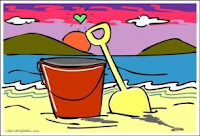skip to main |
skip to sidebar
 Prior to learning mathematics, it is essential for preschoolers and kindergarten students to get hold of pre-math skills. These include learning how to count numbers and knowing their proper sequence (such as 1 comes before 2, 2 before 3, and so on), learning to count everyday objects, and identify the concepts of less and more. In short, math is so much more than counting and adding for young children.
Prior to learning mathematics, it is essential for preschoolers and kindergarten students to get hold of pre-math skills. These include learning how to count numbers and knowing their proper sequence (such as 1 comes before 2, 2 before 3, and so on), learning to count everyday objects, and identify the concepts of less and more. In short, math is so much more than counting and adding for young children.
 The concept of mathematics, if you take time to look for them, can be found in almost all of your child’s daily routine. For example, when you kid plays with building blocks, she learns to group and classify them according to her preference. Or when she plays store, she begins to use the idea of “how much” or “how many”.
The concept of mathematics, if you take time to look for them, can be found in almost all of your child’s daily routine. For example, when you kid plays with building blocks, she learns to group and classify them according to her preference. Or when she plays store, she begins to use the idea of “how much” or “how many”.
There are practically many skill areas that your child can learn and practice math, even in simple coloring activity. Yes, kids love to doodle - give them a box of crayons and watch them transform your walls into graffiti art). Of course we don’t want that, but at least we know that coloring is sure to draw their attention.
The following are links to 10 individual coloring pages in PDF format, each representing the numbers from 1 to 10 along with matching number of objects.
You can print one for each day or print all of them at once (to save on electricity) but only have your child learn each number by letting her color one page at a time. Your focus is not on the colors so let your kid choose on her own – let her have some fun by experimenting.
 The important thing is that you emphasize the number as she is coloring - its appearance and pronunciation. Then as she starts to color more pages (preferably in sequence), slowly introduce the idea of quantity - the difference in the number of objects present in each page.
The important thing is that you emphasize the number as she is coloring - its appearance and pronunciation. Then as she starts to color more pages (preferably in sequence), slowly introduce the idea of quantity - the difference in the number of objects present in each page.
It is not expected that your child will get everything during the first few tries. She may exhibit some "resistance" once in a while so don't push it. As long as she's having fun you can take things gradually.
With frequency, practice, and of course... your patience, you could be unlocking the next math aficionado within your child.
 The Twelve Olympians, also known in ancient Greek mythology as the Dodekatheon (12 gods), were the principal gods of the Greek pantheon residing at the top of Mount Olympus.
The Twelve Olympians, also known in ancient Greek mythology as the Dodekatheon (12 gods), were the principal gods of the Greek pantheon residing at the top of Mount Olympus.
Throughout antiquity, there were debates among historians (and scholars as well) as to who among the various deities comprise the original group of twelve.

 Zeus (roman name Jupiter)
Zeus (roman name Jupiter)
God of the sky and ruler of the Olympian Gods. He is represented as the god of justice and mercy, the protector of the weak, and the punisher of the wicked. Also known as the god of battle, games, and agriculture.


Hera (roman name Juno)
Patroness of marriage. Wife of Zeus. Goddess of love, beauty and fertility. She represents the values of sacred love and marriage as well as female sensuality and desire.


Hades (roman name Pluto)
Lord of the underworld, ruling over the dead. Also known as the god of wealth, due to the precious metals mined from the earth. Brother of Zeus and Poseidon.


Hestia (roman name Vesta)
Goddess of the hearth and fire. Of all the Olympians, she is the mildest, most upright and most charitable. Considered to represent personal security and happiness.


Hermes (roman name Mercury)
Messenger to all the other Gods and the cleverest of the Olympian Gods. He is the fastest of the Gods. He is the god of commerce, road, trading, and eloquence. He was also the god of athletes and is given credit for inventing boxing and racing.


Poseidon (roman name Neptune)
God of the sea and earthquakes. Brother of Zeus and Hades. Son of Cronus and Rhea.


Hebe (roman name Juventas)
Goddess of youth. Daughter of Zeus and Hera. Wife of Hercules. Cupbearer for the gods, serving their nectar and ambrosia.


Ares (roman name Mars)
God of war, frenzy, hatred, and bloodshed. Son of Zeus and Hera.


Hephaestus (roman name Vulcan)
He is the god of fire, craftsmen and smiths. He is the patron god of both smith and weavers. He is the smith and armorer of the Gods.


Athena (roman name Minerva)
Greek virgin Goddess of reason, intelligent, activity, arts and literature. She is goddess of the city, handicrafts, and agriculture. She is the embodiment of wisdom, reason, and purity.


Artemis (roman name Diana)
Goddess of chastity, virginity, the hunt, the moon, and the natural environment. She is the lady of the wild things. She is the huntsman of the God. She is the protector of the young.


Apollo (roman name Apollo)
He is the god of music, poetry, archery, prophecy, justice, law, order and the art of healing. Also known as the sun God. Son of Zeus and Leto, and has a twin sister - Artemis.
 Did it ever occur to you what your baby is thinking when she’s staring at you or at the things surrounding her crib? How many times have you asked her what she likes to do or what she wants to eat? Were you ever confused as to what's really bothering her? Were you constantly juggling between a list of TO DOs as to what would really please her? Ever wished that your baby can just “talk” back?
Did it ever occur to you what your baby is thinking when she’s staring at you or at the things surrounding her crib? How many times have you asked her what she likes to do or what she wants to eat? Were you ever confused as to what's really bothering her? Were you constantly juggling between a list of TO DOs as to what would really please her? Ever wished that your baby can just “talk” back?
With sign language, parents can take advantage of their babies’ natural capabilities to communicate more readily, reducing the stress for the whole family! When toddlers are able to convey the things that they want and that they know they are understood, their level of frustration diminishes significantly. Tantrums are usually caused by toddlers’ inability to communicate their needs and/or wants. Using sign language, parents are able to communicate with their babies in as early as 6 months and reduce the number of tantrums in the long run. Fewer tantrums mean a healthier, better relationship!
 As they grow, infants develop fine muscles in their hands and arms even before they develop those required for speech. Signing with your baby is easy and natural. You can start between 6 to 9 months when your baby starts interacting or learns how to mimic. It is never too early or too late to begin with. Just keep in mind that signing is not an overnight success. Learning how to use specific hand shapes and motions to convey words takes practice, patience, and that “right moment” to use it.
As they grow, infants develop fine muscles in their hands and arms even before they develop those required for speech. Signing with your baby is easy and natural. You can start between 6 to 9 months when your baby starts interacting or learns how to mimic. It is never too early or too late to begin with. Just keep in mind that signing is not an overnight success. Learning how to use specific hand shapes and motions to convey words takes practice, patience, and that “right moment” to use it.
Begin with the Basics
Start with 3 to 5 signs for things you do frequently. The most common signs to start with are MILK, MORE, and EAT. If you know more signs, you can sign more. But, if you are learning along with your child, a handful of signs is a manageable number to start with. Don't push the signs – your child will develop at her own pace. If your baby seems resistant, don't push the issue.
 Use at the Right Moment
Use at the Right Moment
Use the signs every time you are in the right situation. For example, when you nurse or give your baby milk bottle, say "Do you want some milk?" and sign MILK (like pretending to thumb suck or something similar).
Add a Bit of This, a Bit of That
As your child learns a few signs and begins to sign back, start adding other signs like FRUITS (apple, banana, etc.), THIRST (drink as if holding a glass) and HUNGRY (rubbing tummy). Continue to use the signs you already use as you add new ones. Or you can follow your baby. Sometimes, your baby will make her own signs up. If that’s the case, make sure you use her signs, as she will remember these easily.
 Patience is a Virtue
Patience is a Virtue
It takes babies time to learn to sign, but they can recognize the signs long before they can mimic them. For example, babies will often show their anticipation when you sign MILK by grunting or panting. It's a positive sign that they are beginning to understand the purpose of signing. Furthermore, make it a family habit. Anyone your baby interacts with regularly should know the most important signs. This will help with retention.
Parents Need to Study Too
Consider taking a special class to learn the keys to successful signing. Or study at home via self-taught, self-paced signing videos and have fun learning with the entire family. Or check out a book or web site for more information.
Learning should be fun for kids – it’s one way of keeping them interested!
 Prior to learning mathematics, it is essential for preschoolers and kindergarten students to get hold of pre-math skills. These include learning how to count numbers and knowing their proper sequence (such as 1 comes before 2, 2 before 3, and so on), learning to count everyday objects, and identify the concepts of less and more. In short, math is so much more than counting and adding for young children.
Prior to learning mathematics, it is essential for preschoolers and kindergarten students to get hold of pre-math skills. These include learning how to count numbers and knowing their proper sequence (such as 1 comes before 2, 2 before 3, and so on), learning to count everyday objects, and identify the concepts of less and more. In short, math is so much more than counting and adding for young children. The concept of mathematics, if you take time to look for them, can be found in almost all of your child’s daily routine. For example, when you kid plays with building blocks, she learns to group and classify them according to her preference. Or when she plays store, she begins to use the idea of “how much” or “how many”.
The concept of mathematics, if you take time to look for them, can be found in almost all of your child’s daily routine. For example, when you kid plays with building blocks, she learns to group and classify them according to her preference. Or when she plays store, she begins to use the idea of “how much” or “how many”.









 The important thing is that you emphasize the number as she is coloring - its appearance and pronunciation. Then as she starts to color more pages (preferably in sequence), slowly introduce the idea of quantity - the difference in the number of objects present in each page.
The important thing is that you emphasize the number as she is coloring - its appearance and pronunciation. Then as she starts to color more pages (preferably in sequence), slowly introduce the idea of quantity - the difference in the number of objects present in each page.
































